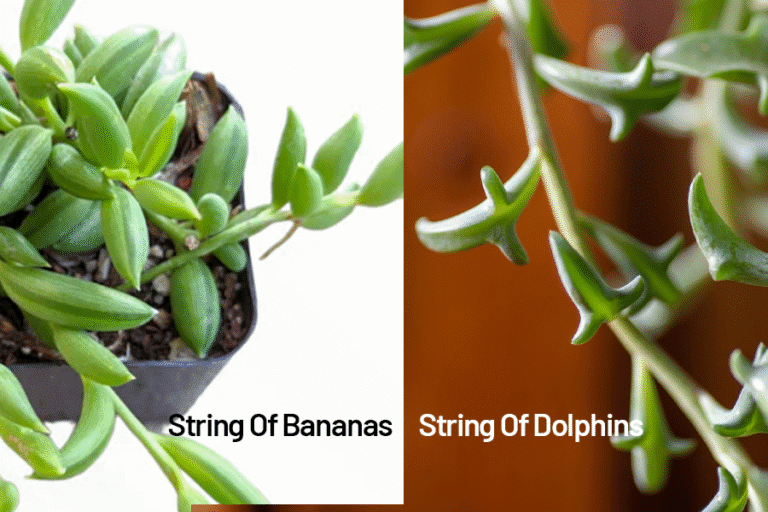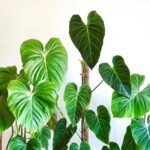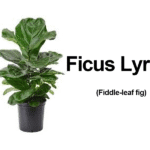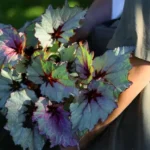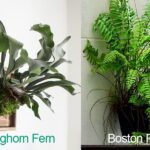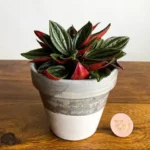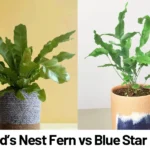String of Bananas vs. String of Dolphins: How to Choose the Right Succulent for Your Indoor Space
Succulent lovers and houseplant fans have fallen hard for the unique charm of trailing plants like String of Bananas and String of Dolphins. With their whimsical leaf shapes and cascading vines, both have become favorites for hanging baskets, shelves, and sunny windowsills. But because they belong to the same plant family and share similar care requirements, these two trailing succulents are often confused. Their names even sound alike!
So what’s the difference between String of Bananas and String of Dolphins, and which one is better for your home? In this guide, we’ll lay out a clear side-by-side comparison to help indoor gardeners and plant newbies confidently tell these plants apart—and choose the one that best suits their space and lifestyle.
Quick Comparison Table: String of Bananas vs. String of Dolphins
| Feature | String of Bananas | String of Dolphins |
|---|---|---|
| Botanical Name & Plant Family | Curio radicans (Asteraceae) | Senecio peregrinus (Asteraceae) |
| Native Region | South Africa | Hybrid: Cross between String of Pearls (S. rowleyanus) and Candle Plant (S. articulatus) |
| Leaf Shape & Size | Curved, banana-shaped leaves, 2–3 cm long | Leaves shaped like jumping dolphins, 1.5–2.5 cm long |
| Growth Habit & Speed | Fast-growing, trailing vines up to 36–48 inches long | Moderate growth, vines 24–36 inches long |
| Stem Structure / Unique Identifiers | Smooth green stems with minimal variegation | Segmented stems, especially in mature growth; distinctive dolphin-like leaf arc |
| Light Requirements | Bright, indirect light (10,000–25,000 lux); tolerates some direct morning sun | Bright, indirect light (12,000–25,000 lux); direct sun causes leaf bleaching |
| Watering & Humidity | Low water; water when soil is fully dry; prefers 30–50% RH | Low to moderate water; water when pot is dry to touch; 40–50% RH ideal |
| Pet Safety / Toxicity | Toxic to cats, dogs, and humans (can cause vomiting & diarrhea) | Toxic to pets and humans (due to pyrrolizidine alkaloids) |
| Availability & Typical Price | Widely available; $8–$15 for 4” pot | Moderately available; $12–$20 for 4” pot |
Major Differences Between String of Bananas and String of Dolphins
1. Leaf Shape and Visual Identity
The most noticeable—and charming—distinction between String of Bananas and String of Dolphins is the foliage shape. String of Bananas has elongated, crescent-shaped leaves that curve much like miniature bananas. In contrast, String of Dolphins lives up to its name with leaves that resemble playful, arched dolphins leaping out of water. Each dolphin leaf even appears to have a ‘fin’ due to a special notch that develops as it matures. This vivid look makes String of Dolphins a conversation piece and ideal for whimsical décor themes.
2. Growth Habit and Size
If you’re looking to fill space quickly or want an eye-catching cascading plant, String of Bananas is the more vigorous grower. It can put on substantial length in just one growing season and regularly reaches up to 3–4 feet indoors. String of Dolphins grows more slowly, often taking a full year to develop vines longer than 2–3 feet. Its more compact and controlled growth might be a better match for small shelving or contained wall installations.
3. Care Requirements and Sensitivity
Both plants are succulent in nature, preferring dry soil and lower humidity compared to tropical houseplants. However, String of Dolphins tends to be a bit more sensitive to overwatering and sun exposure than String of Bananas. While Bananas can tolerate a bit of direct morning sunlight and bounce back from brief neglect, Dolphins are prone to leaf scarring or color fading if exposed to too much light or erratic moisture. This makes String of Bananas marginally more forgiving for new plant parents.
4. Indoor Placement and Aesthetic Use
The architectural difference in stem and leaf repetition means each plant makes a different visual statement. String of Bananas, with its uniform texture and classic succulent greens, looks sleek and lush in modern or minimalist settings. String of Dolphins, with its quirky silhouette, is more of a novelty piece—perfect for playful interiors or as a gift for ocean lovers. When hung, both produce lovely trailing curtains, but Dolphins tend to grow more compactly and upgrade a small corner with personality.
Which One Should You Choose?
Still not sure which plant is right for you? Let’s match these trailing beauties with specific home setups and needs:
- Best for beginners: String of Bananas. Faster growing, more adaptable to varied light and watering habits.
- Best for compact spaces or shelves: String of Dolphins. More contained growth and whimsical silhouette fit cozy fits just right.
- Best for statement décor: String of Dolphins. The unique leaf shape draws immediate attention and adds playful character.
- Best for sunny windows: String of Bananas. Tolerates morning sun and bounces back from slight neglect more easily.
- Low-light homes: Neither thrives in low light. Both need 10,000+ lux to maintain leaf shape and growth. Use a grow light if necessary.
- Pet-friendly households: Unfortunately, neither plant is safe for cats, dogs, or small children if ingested. Consider an alternative like Peperomia hope or Spider Plant if pet safety is a priority.
Conclusion
String of Bananas and String of Dolphins are both delightful trailing succulents with similar care needs but distinct personalities. Their different leaf shapes, growth habits, and light sensitivities offer indoor gardeners a choice based on style, space, and lifestyle. If you want visual charm that grows fast and strong, go for the reliable and lush String of Bananas. If you want something novel and artistic, let String of Dolphins leap into your collection.
Whichever you pick, both plants will appreciate a bright window, well-draining soil, and occasional drought. Give them time, light, and the right environment, and you’ll have a delightful cascade of greenery (or porpoises!) beautifying your home year-round.
References
- Brickell, C. (2019). RHS Encyclopedia of House Plants. Dorling Kindersley.
- Hessayon, D. G. (2015). The House Plant Expert. Expert Books.
- The American Society for the Prevention of Cruelty to Animals (ASPCA). (2023). Toxic and Non-Toxic Plants List. https://www.aspca.org/pet-care/animal-poison-control/toxic-and-non-toxic-plants

